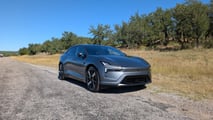
Polestar has long had an identity crisis. After being spun out of Volvo’s performance division back in 2017 to become a separate brand, the two still feel like siblings who share the same closet. They’re both premium Sino-Swedish brands that pick from the same parts bin for their models, collaborate closely on engineering and are under the same Geely Group parent company.
But the Polestar 4 could mark a turning point for the brand. It might help Polestar set itself apart from its Swedish sister brand and finally chart its own fully electric path as Volvo plans to continue selling combustion engine models well into the next decade.

The Polestar 4 is a sleek, coupe-shaped crossover that slots between the Polestar 2—currently discontinued in the U.S.—and the larger Polestar 3 SUV. My colleague Kevin Williams drove it in Spain last year. He found the EV capable, but missed the traditional rearview mirror, which the Polestar 4 replaces with a digital unit inside due to the lack of a rear window.
Last week, I got behind the wheel of the U.S.-spec version in Austin, Texas, to find out whether this electric crossover can reignite Polestar’s sluggish American business and carve out its own space in an increasingly crowded electric crossover market. After spending an afternoon with it, the Polestar 4 felt like it was brimming with personality, both in the way it drives and the way it feels inside. It falls short of some rivals in terms of specs, but it makes up for that with a striking design and a driving experience that's tailored for enthusiasts—and with a lot of personality to boot.
Oh, and that deleted rear window? Let's unpack that.
(Full Disclosure: Polestar invited me to Austin, Texas, for the first drive of the U.S. spec Polestar 4. The company paid for travel and lodging.)
Gallery: 2026 Polestar 4







Polestar 4: Specs And Basics
The Polestar 4 has more in common with the Zeekr 001 than other Polestar models. It rides on the Chinese parent Geely Group’s Sustainable Experience Architecture (SEA), which it also shares with the Volvo EX30. But in terms of pure specs, it falls a level below the Zeekr.
While the Zeekr 001 rides on a 900-volt architecture, making it capable of charging from 10% to 80% in just seven minutes, the Polestar 4 rides on a 400-volt architecture.
That means its 100-kilowatt-hour CATL battery can charge from 10-80% in 30 minutes with a peak 200-kilowatt rate. That’s far from class-leading, but in the same ballpark as the Tesla Model Y and still better than the Cadillac Lyriq. [I was not able to perform a charging test during my drive.]

Still, Polestar engineers said there’s plenty in common with Zeekr models. Some of the battery pack components, drive motors, steering rack, wiring and even the seat structure are shared with the Zeekr 001.
Because the Zeekr has been on sale longer in China, the company has already fine-tuned some of these systems, so component sharing made even more sense to save both time and money. The suspension calibration and brakes are unique to the Polestar 4.

It will be available in two trims, single motor and dual motor. The single motor version sends 272 horsepower and 253 pound-feet of torque to the rear wheels and delivers an EPA-estimated 310 miles of range. It does the 60 miles per hour sprint from a standstill in 6.9 seconds, according to Polestar.
The dual motor ups the output to 544 hp and 506 lb-ft, along with a range of 280 miles. It races to 60 mph in a claimed 3.7 seconds. Both versions have a top speed of 124 mph.
2026 Polestar 4
It’s A Riot Behind The Wheel
The dual-motor version feels diabolical under hard acceleration. It unleashes all that torque with abandon, slams your back into the seat, and from then on, you’re basically flying through a wormhole.
There’s plenty of adjustability, too. Range mode maximizes efficiency by decoupling the front electric motor, which can switch back on in a fraction of a second when the surface gets loose. Performance mode unlocks all the available power and torque. My observed efficiency in mixed city and highway driving was 3.0 miles per kilowatt-hour.
The adaptive dampers and precise steering do an impressive job of disguising the Polestar 4’s nearly 5,200-pound curb weight, especially in the Standard and Firm settings. You still feel the heft, but the car corners remarkably flat and changes direction with the agility of something that feels far lighter.

The Standard suspension mode strikes a great balance between everyday comfort and spirited driving, while Firm sharpens everything to the point of harshness, meaning every small road imperfection can be felt in your seat squab, so it’s best saved for track days or fresh asphalt.
If you’re feeling bold and have the skill to back it up, you can switch traction control off and tame the Polestar 4 into a four-wheel drift. I turned ESP off once and floored it through a corner. All four wheels lit up and I promptly turned ESP back on before I did something I’d regret.
But the dual-motor version feels like overkill. Most buyers will never come close to using all that power. The single-motor, rear-wheel-drive Polestar 4 felt far more friendly and approachable. It’s also nearly 300 pounds lighter, which you can feel from behind the wheel.
The RWD felt more agile, with a predictable turn-in. It’s more playful through corners and responds beautifully to subtle inputs. Lift off slightly and the front bites harder. As you brake, turn and accelerate, it nicely rotates around you, whereas the AWD just aggressively lurches forward.
For everyday driving, this is the one I’d recommend, provided you don’t live somewhere with snow or absolutely need the extra traction of AWD.
It's A Head Turner

Polestar said it ditched the rear window to maintain the coupe-like design, while retaining the vehicle’s structural stiffness and interior headroom. Instead, it gets a camera at the rear which sends a feed to the digital rearview mirror inside, which looked crisp, bright and clear.
Still, that doesn't negatively affect the overall design. At least to this pair of eyes, the Polestar 4 is one of the most handsome crossovers on the market, with beautiful proportions, one that would turn heads at the valet parking or when you pull up to a crowd.
The split T-shaped LED signatures up front give it a solid dose of modern appeal while preserving the minimalist design language. The divided lamp design also adds visual identity, distinguishing it from Volvo’s “Thor’s Hammer” lights.
At the rear, the absence of a windshield gives it a clean and sculpted look. Its body-colored aluminum panel, replacing the windscreen, seamlessly flows into the full-width light bar that ties the design together. It looks sleek, cohesive and modern, especially from the rear three-quarter angle.
Cabin Feels Top Notch

The cabin feels both premium and distinctly high-tech, thanks to the 15.4-inch center display that’s now horizontally oriented, unlike the portrait-style screen in the Polestar 3. Powered by Qualcomm’s 8155 chip, it’s snappy and responsive. I'd like to think it's as good as the Tesla screens. The interface runs on Google’s Android Automotive operating system with Polestar’s custom user interface layered on top and wireless Apple CarPlay comes standard.
The built-in Google OS brings native apps like Google Maps and Google Assistant, plus there's a full Play Store where you can download compatible apps. The climate settings rest on a black bar at the bottom of the screen and also feel very Tesla-like. It will also debut Google's new Live Lane Guidance feature, which shows a real-time visualization of the road ahead for more accurate navigation. However, the feature wasn't available on the test cars and will come later through an OTA update.
Everything, including air vent adjustability, has to be done from the screen. It also has some unique touches. It allows you to select Animal Mode, which keeps the vehicle's climate on when you're out doing groceries, with the animation of a robotic dog.

Materials are top-notch throughout, with generous use of soft-touch surfaces. The seats are upholstered from an accented open mesh material which Polestar calls Tailored Knit, 85% of which is sustainably sourced and is fully traceable. The bucket seats felt slightly firm, going with the car's personality, but comfortable overall. And the massive curved panoramic roof is the largest single unit I've seen in a car, adding plenty of light inside.
Polestar 4: Early Verdict
The Polestar 4 goes on sale this fall, starting at $56,400 for the single-motor version and $62,900 for the dual-motor, before taxes and destination.
In terms of pricing, it seems closer to the upcoming Neue Klasse BMW iX3, which is expected to start under $60,000 and will be vastly superior overall with things like zonal architecture, faster charging speeds and bidirectional charging. The Mercedes-Benz GLC EV is expected to be of the same caliber as the iX3.

The Polestar 4 is more aligned with crossovers that are far cheaper. The Tesla Model Y Premium undercuts it by about $11,000 while offering more range, better software and the Full-Self Driving (FSD) advanced driver assistance system (If you’re into that). The Cadillac Optiq is $5,000 cheaper than the Polestar 4 and offers more standard equipment, like an AKG sound system and Super Cruise. They also get a factory-fitted NACS port, while the Polestar still relies on CCS, though it can access Tesla’s Supercharger network with an adapter. In terms of pure value, the competition has the upper hand.
Yet that doesn’t diminish what the Polestar 4 does exceptionally well. It’s arguably one of the most engaging EVs to drive on the cheaper end of a Porsche Macan Electric. Its minimalist Scandinavian styling stands out. Inside, the Android Automotive infotainment system is cleanly executed and impressively integrated, feeling intuitive and easy to use.
Overseas, this formula seems to be working. Polestar’s global sales grew 36% in the first nine months of this year, with the Polestar 4 becoming the brand’s top-selling model in Germany.
But the U.S. market is a different beast, where competition is rising and the $7,500 federal tax credit no longer exists. Whether the Polestar 4’s quirkiness becomes its strength or ends up being a vulnerability in an uncertain market remains to be seen.
Have a tip? Contact the author: suvrat.kothari@insideevs.com

!["[T]he First and Fifth Amendments Require ICE to Provide Information About the Whereabouts of a Detained Person"](https://images.inkl.com/s3/publisher/cover/212/reason-cover.png?w=600)






